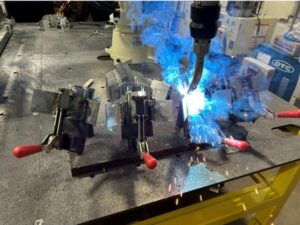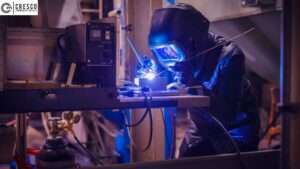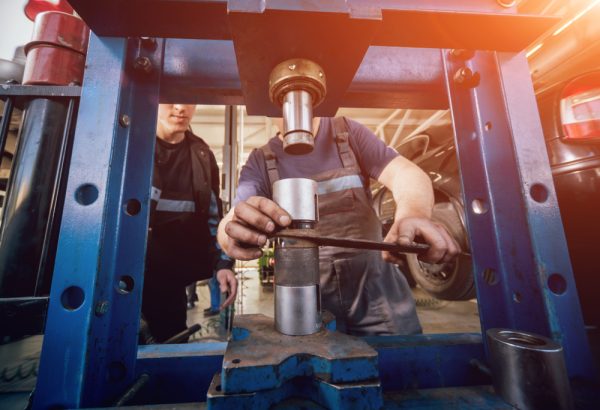The Inclusion of Robotics in Metal Welding Processes
Currently, robotics has taken the central stage in transforming industries worldwide. The metal welding sector is no exception in incorporating the unique contribution of robotics. Integrating robotics into the welding procedure has revolutionized how we think about manufacturing, quality, and efficiency. As businesses seek to optimize their production lines and increase workplace safety, robotic welding systems have become indispensable for achieving these goals.

This blog will demonstrate how robotics can reshape the welding industry, the benefits it provides, and why it is a trend that is here to stay.
Why robotics in welding?
Conventional welding procedures have long relied on skilled human labor. Being practical, manual welding poses challenges like inconsistent quality, safety risks, and worker fatigue due to exposure to extreme heat, sparks, and fumes. By incorporating robotics, manufacturing can address different challenges while remarkably boosting consistency and productivity.
Robotic welding systems are designed to automate tasks with repeatability and precision. Whether it is MIG, TIG, or plasma welding, these systems can execute complex welds with specifications that is hard to achieve manually. This level of precision makes robotics systems perfect for high-volume production and industries that demand stringent quality standards, including automotive, construction, and aerospace.
Benefits of Robotic Welding Systems
- Increased efficiency and productivity
One of the most significant advantages of robotic welding is the capability to work consistently without requiring breaks. Unlike human workers, robots can function 24/7, dramatically increasing output. It is especially beneficial for large-scale manufacturing where meeting tight deadlines is important.
- Enhanced weld quality
Robotic systems provide constant weld quality by reducing human errors like uneven welds or missed spots. Advanced sensors and programming assure precise control over welding parameters, resulting in stronger and more durable joints.
- Costs savings
While the beginning of investment in robotic welding systems can be substantial, the long-term cost savings are undeniable. Eliminated material waste, decreased labor costs and minimized rework all contribute to a faster return of investment.
- Improved workplace safety
Welding is initially dangerous, exposing workers to risks including toxic fumes, electric shocks ,and burns. Robotic system can perform these risky tasks in place of human workers, eliminating workplace injuries and creating a safer environment.
- Flexibility and scalability
Modern robotic welding systems are incredibly adaptable. They can be programmed to manage different welding tasks for accommodating design changes, making them perfect for manufacturing who require flexibility. Along with this, they can simply scale operations to meet the increasing demand without compromising quality.
Applications of Robotic Welding
Automotive industry
The automotive industry has been one of the simplest adopters of robotic welding. Robots are extensively utilized to weld car frames, exhaust systems and other components, assuring uniformity and precision.
Aerospace industry
Within the aerospace industry, where precision are paramount, robotic welding systems play an important role in joining intricate components. These systems assist in maintaining the structural integrity of aircraft parts.
Construction and infrastructure
Robotic welding is increasingly being used in construction to fabricate steel structures and heavy machinery. This consistency and the speed of robotic systems are essential for large-scale infrastructure projects.
Energy sector
From pipelines to wind turbines, robotic welding systems are important for the energy industry. They can assist in producing durable welds which can withstand extreme conditions of the environment.
Challenges and considerations
While integrating robotics in welding offers various benefits, it is not without challenges. For example, the high initial costs of robotic systems can challenge small and medium-sized enterprises (SMEs). Along with this, implementing these systems need operators and programmers to assure they function optimally.
Other consideration is the management of robotic systems. Regular upkeep is essential to prevent downtime and assure long-term reliability. Manufacturers should also consider the compatibility of robotic systems with the present production lines in case additional training is required for their workforce.

Future Trends in Robotic Welding
With the continuous growth of technology, the future of robotic welding looks brighter than ever. Some key trends to watch are:
- Artificial intelligence (AI) integration
AI-powered robotic systems can analyze information in real time to optimize welding procedures. It includes dynamic adjustment of parameters to account for material variations or environmental alterations.
- Collaborative robots (Cobots)
Cobots are curated to work alongside human operators, combining the strength of human expertise and robotic precision. These systems are specifically useful for smaller workshops where space is constrained.
- IoT and Industry 4.0
The Internet of Things (IoT) allows robotic welding to communicate with other machinery, providing a connection and intelligent production environment. This integration increases efficiency and allows for predictive maintenance.
- Advanced sensor technology
New sensor technologies, including laser tracking and 3D vision systems, are enhancing the adaptability and accuracy of robotic welders, making them perfect for more complex tasks.
FAQs About Robotics in Welding
- What are the main advantages of using robotic welding systems?
Increased productivity, better weld quality, cost savings, increased workplace safety, and more flexibility are all benefits of robotic welding systems. They are perfect for high-volume production since they can run constantly and produce reliable output.
- Are robotic welding systems suitable for small businesses?
Even though the initial cost could be prohibitive, a lot of small businesses are figuring out how to use robotic welding through government incentives, leasing programs, or integrator partnerships. The long-term advantages frequently outweigh the initial investment.
- What industries benefit the most from robotic welding?
Robotic welding greatly benefits the automotive, aerospace, construction, and energy industries because these sectors require accuracy, scalability, and constant quality.
- How does AI enhance robotic welding?
Through real-time data analysis, parameter adjustments, and increased overall efficiency, artificial intelligence (AI) enables robotic systems to enhance welding operations. Better weld quality and less material waste result from this.
Including robotics in metal welding processes marks a significant leap forward for the industry. By embracing this technology, manufacturers can enhance their capabilities, stay competitive, and pave the way for a safer and more efficient future.


